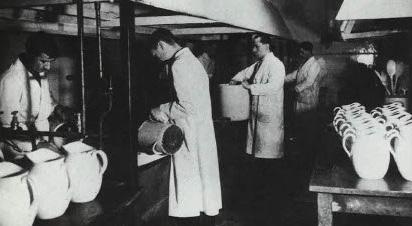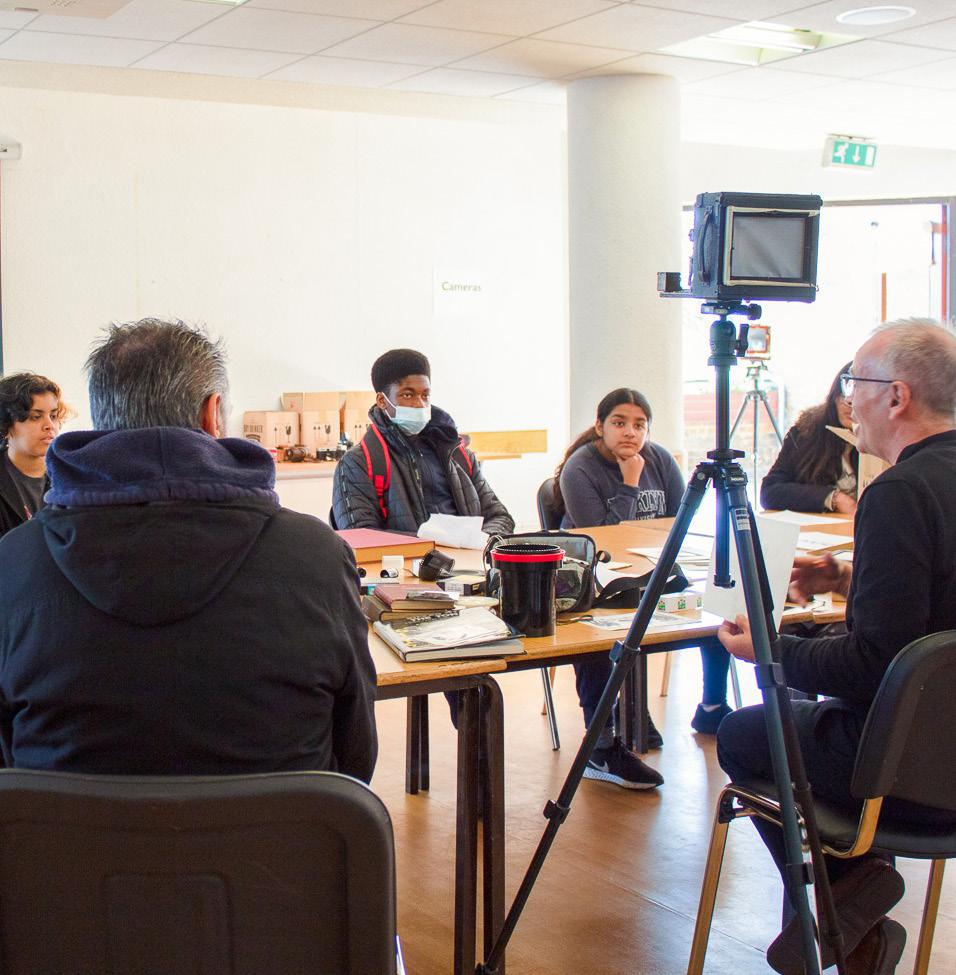
7 minute read
Ilford through the lens
Packaging paper in 1894 © Courtesy of Michael Talbert ‘photomemorabilia.co.uk’

A rich photographic heritage has inspired the design of a child-friendly public realm built on the site of the former Ilford factory.
With an emphasis on child-friendly design, the newest urban quarter in Ilford and one of Redbridge’s largest regeneration schemes was given a resolution to grant planning just before Christmas. Connecting the area’s rich industrial heritage with a relatable and hospitable landscape for children provided a unique placemaking opportunity.
Harnessing the abundance of opportunity that the £18.8 billion Crossrail project is bringing to Ilford, this Telford Homes scheme features 837 new homes and 447 student accommodation bedrooms with 3,500m²+ of commercial floor space, and almost 7,000m² of new public realm. With the potential to set a precedent for future development in the area, this development will mark a significant change of use and improve permeability in central Ilford.
As one of only a few UNICEF child-friendly boroughs in the country, Redbridge Council advised Telford Homes on a specialised engagement strategy. Chapel Place was named as the pilot scheme within the council’s Child-Friendly Action Plan, and Telford have therefore taken as many opportunities as possible (to date) to put youth engagement at the heart of this strategy. While child-centred design was a key element – with youth ambassadors influencing the design from the outset, framing the engagement process was the industry transforming innovation that has characterised Ilford’s past.
Celebrating the heritage of Ilford, the design narrative focuses on the former Ilford Ltd (previously Britannia Works Factory) – a photographic plate factory – on which the development is planned. Founded by Alfred Harman in 1883, Ilford Ltd developed innovative photographic technologies including glass photographic plate production, the silver emulsion to create photosensitivity, and film and cameras which transformed the photography industry at the time.
Our design for public realm at Chapel Place was inspired by the innovative technologies that succeeded in putting Ilford on the world map. Concept design sketches were developed, refined and folded into this design narrative. Two concepts based on the fluidity of silver emulsion and photographic plate geometries were used within the site to help create two distinct areas. The photographic plate concept was applied to an urban linear space which would function as a retail and commercial corridor, while the more curved silver inspired spaces would be more suitable for a central green space (named Britannia Gardens – reflecting a former green space in the factory grounds) that would form the heart of the development.
To strengthen the link with the heritage of Ilford Ltd, its branding and packaging colour schemes of sands, buffs and greys were used to inspire the hard and soft material palette. Intended to reinforce distinct character areas in the site, these paving designs and colours created a natural navigation through the site. Similarly, planting and furniture designs utilised the bright colours of the packaging labels through flower and seed head colours and powder coated accents to the metal work of the furniture.

Innovations of Britannia Works factory
© Courtesy of ‘Silver by the Ton: A History of Ilford Limited 1879-1979’

Innovations of Britannia Works factory
© Courtesy of ‘Silver by the Ton: A History of Ilford Limited 1879-1979’

Innovations of Britannia Works factory
© Courtesy of ‘Silver by the Ton: A History of Ilford Limited 1879-1979’
Enshrined across Redbridge policy is a commitment to children’s rights at the heart of every council decision. With 25% of Redbridge’s half a million residents aged 0–15, achieving UNICEF UK Child Friendly Community status for Redbridge was a key manifesto pledge for the current administration. Redbridge’s Child Friendly Action Plan provides a UNICEF-aligned programme to put children’s educational development at the centre of public space design. Ensuring that key design priorities on Chapel Place were linked to the UNICEF child rights principles was important for framing the public realm and landscape strategy. UNICEF Child-Friendly Cities Initiatives1 explore ways of elevating community voices, needs, priorities and rights of children, allowing them to form an integral part of public policies, programmes and decisions. The initiative’s practical toolkit based on the seven Principles of the UN Convention on the Rights of the Child were used by designers to ensure that at no point in the design process were children an afterthought. Divided into general principles (Life, Survival and Development; Non-Discrimination; and Participation) and human-rights principles (Dignity; Interdependence and Indivisibility; Transparency and Accountability), they ensure a quality of care and provision in children’s lived experience.
For this scheme, we partnered with UP Projects to empower young people to shape the narrative through both public art and infrastructure. Using the photographic heritage of Ilford Ltd as a lens to frame engagement, workshops included meeting local Ilford artist Andrew Brown to look at Ilford Ltd’s heritage items and explore photographic techniques.

Proposed Britannia Gardens’ allocated open space
© Image courtesy of Rockhunter

Proposed Britannia Gardens’ allocated open space
© Image courtesy of Rockhunter
This strategy provided an opportunity for an emerging neighbourhood to connect with communities both old and new as the project started to take shape. It allows art and creative practice to sit at the heart of this development and gives people the chance to develop what and how this cultural offer might shape and deliver tangible social value to both young people and adults.

Ilford Community workshop activities
© Copyright Up Projects Consultation Curator and run by local artist Andrew Brown.
This philosophy remained at the heart of the strategy and design of Chapel Place. Structuring engagement sessions with activities for young people to participate in led to helpful design responses that the design team could incorporate, such as space promoting digital arts innovation and a community hub to access digital art technology.
Seeing how photography could inspire young people, Ilford’s photographic heritage played a key part in devising Chapel Place’s play strategy, with the design of individual features inspired by different photographic key principles: perspective, light, texture and colour. These features include a silver-themed climbing feature; picture frame-inspired play features; brightly coloured play items representing the packaging materials; and iridescent objects that play tricks on the eye by shifting with light and shadow. Similarly, it was determined that any public art should, as well as reinforcing historical narratives, be functional and used for play or seating.

Photographic plate production concept sketch
While these principles framed the design approach, implementation of child-friendly design has to be relevant to the context. Harnessing the lived experience of Redbridge Youth Ambassadors through engagement gave children an opportunity to shape placemaking strategies and ‘places’ where they feel connected. The crux of the challenge with Chapel Place was to make the powerful heritage relevant to the modern youth perspective, in so connecting the past with the future.

Camera aperture concept sketch
© Courtesy of Michael Talbert ‘photomemorabilia.co.uk’

Packaging paper in 1894
© Courtesy of Michael Talbert ‘photomemorabilia.co.uk’
As placemaking specialists, creating successful public realm can create a multitude of challenges and overlooking young people can limit success. Young people demonstrate energy and dynamism that should be nurtured and catered for. While Chapel Place is inspired by the past, the engagement with local young people has shaped a relevant design for the future. As Chapel Place has already been given a resolution to grant planning, moving forward into the next stages of design, its future success hinges on ensuring these young voices are heard.

Aspirational townscape sketch depicting the development and changing Ilford context
© Image courtesy of HTA Design
Client: Telford Homes and Sainsbury’s
Team: HTA Architects (Lead Consultant), UP Projects (Public Art and Consultation), Mayer Brown (Transport), Ramboll (Engineers)

Proposed Chapel Way Winston Way Gateway
© Image courtesy of Rockhunter
Pierre Chin-Dickey CMLI, CLARB, LEED A.P. is a landscape architect and Design Director at Macfarlane + Associates
James Blower MA – Urban Designer and Sustainability Lead at Macfarlane + Associates










